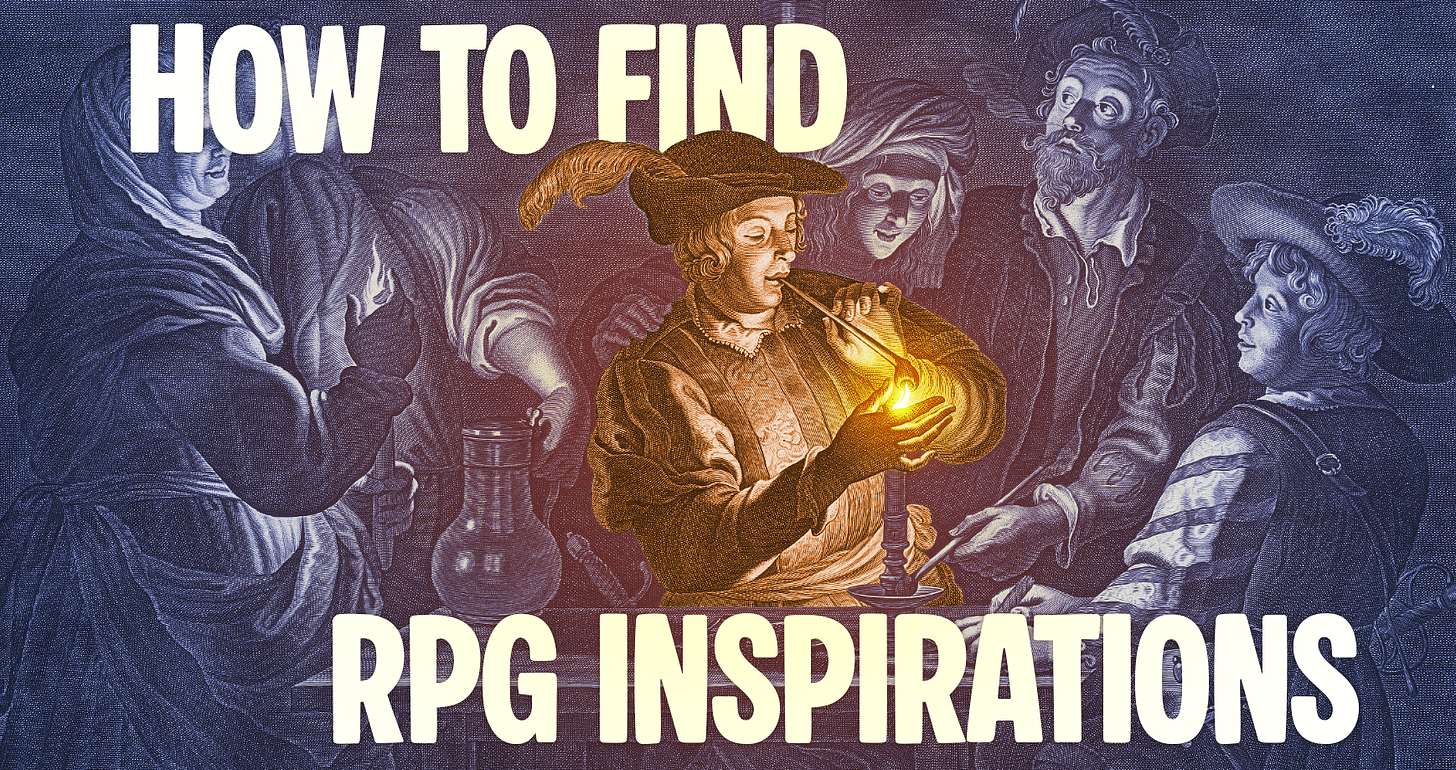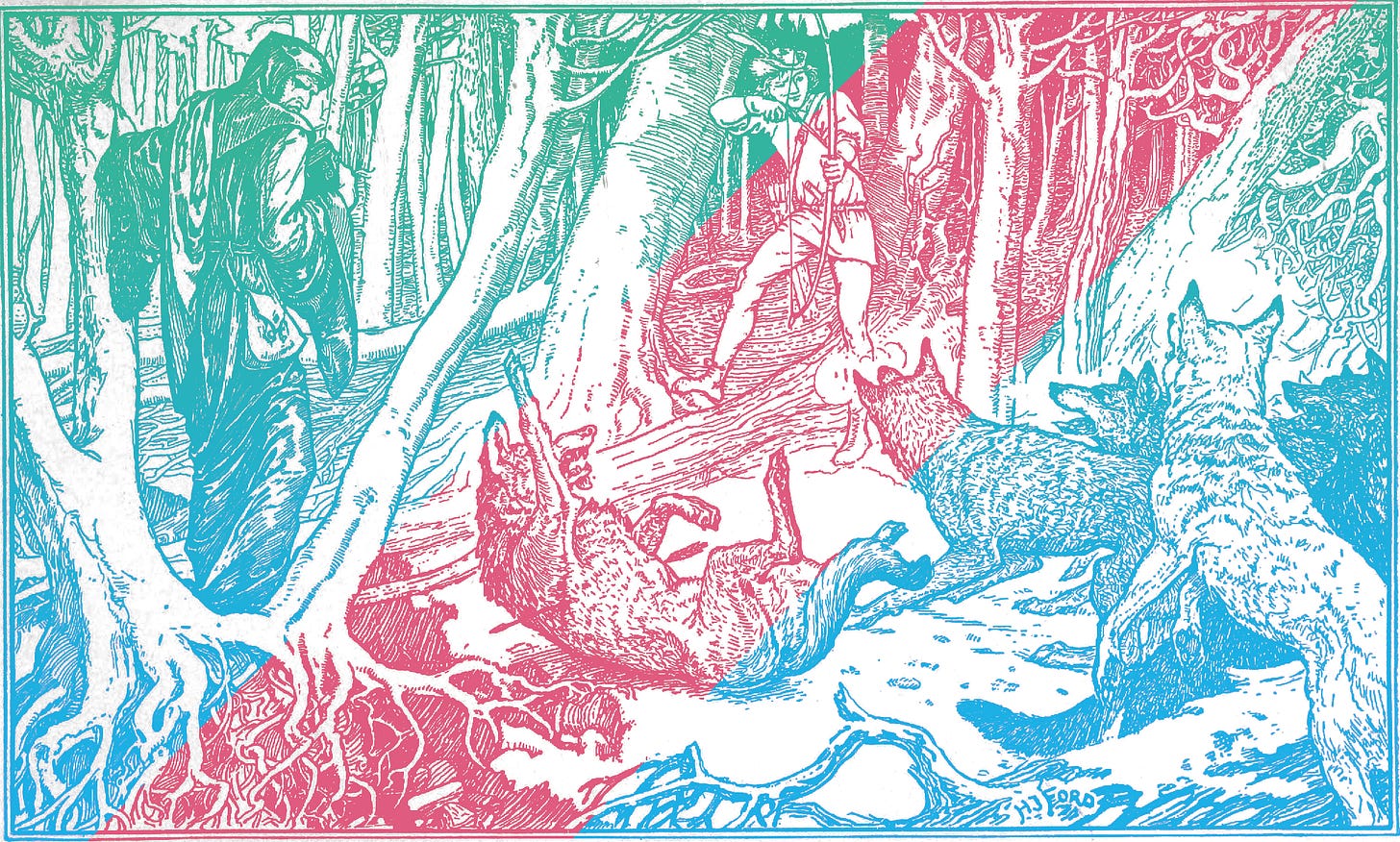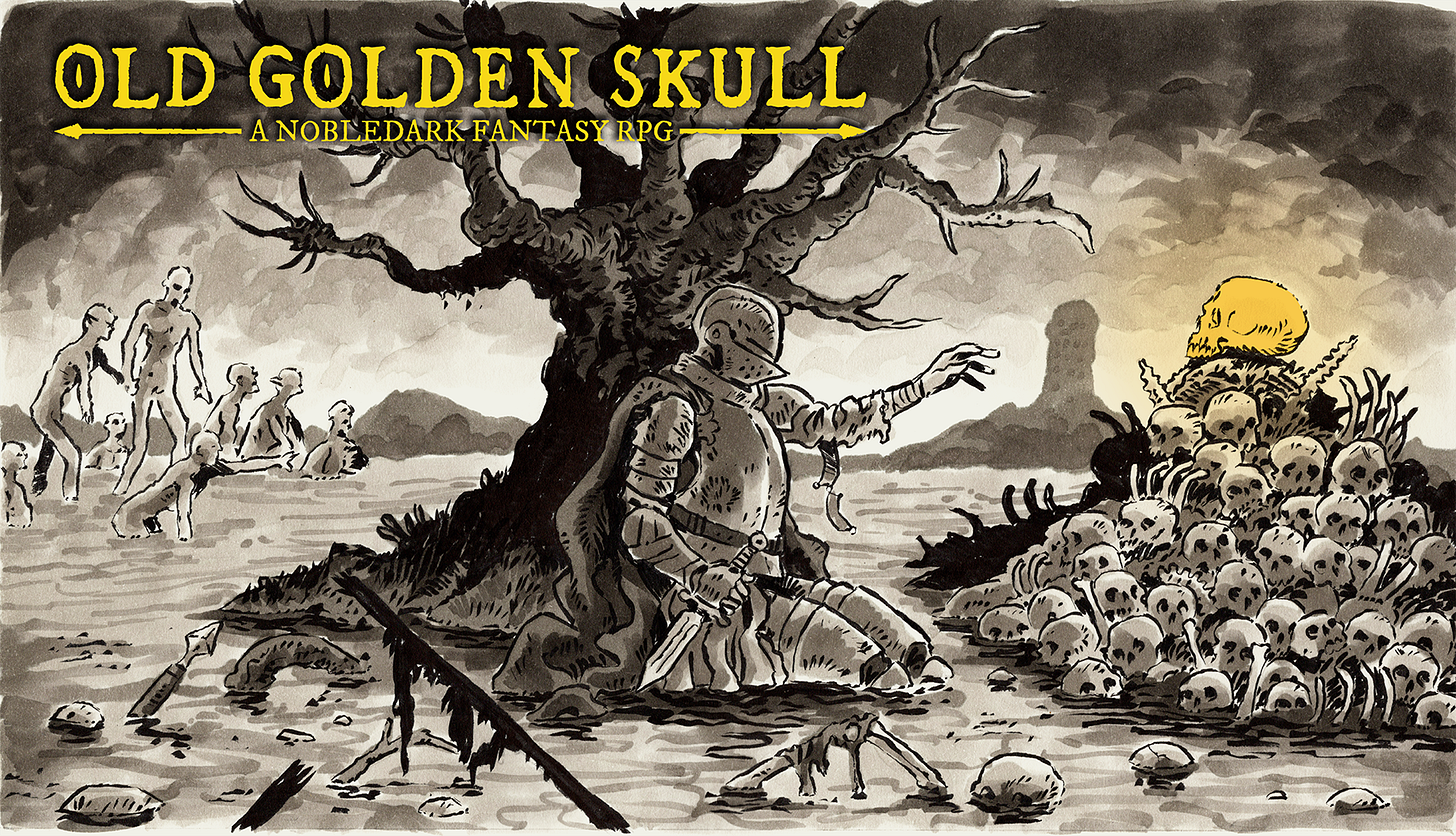How to find and use your RPG inspirations
Let's find some references with this new article!
Greetings my fellow warlocks, and welcome to the Tome of Oddz, by Novecento!
After tackling how to start making your own RPG stuff, today we will tackle one of the most overlooked parts in RPG creativity: Inspirations!
IN THIS LETTER:
💡A word about inspirations
💡How to find inspirations
💡Avoiding rip-offs
💡Tips on how to use references
A WORD ABOUT GETTING INSPIRED
I think one of the most crucial parts when it comes to making your own RPG stuff (be it simple NPCs or a full-blown campaign), is gathering inspirations and using them to create something unique.
After all, we can say this hobby was born with people who were very inspired by Fantasy literature, so we wouldn’t be so much far off in saying part of this hobby is crafting something out of your inspirations.
But many of us might have been hit by a few doubts when it comes to inspirations: How do we find them? How do we avoid being derivative, or even avoid falling into plagiarism? How can you use your inspirations as references?
Well before we try to answer to all of these questions, I think it’s worth talking how to avoid ripping off stuff.
HOW TO AVOID RIP-OFFS
Let’s face it: we were all young and we all made that RPG campaign that was “TOTALLY NOT MY FAVORITE BOOK OR VIDEOGAME”, which was, indeed, our favorite book or videogame but in RPG format.
And by all means, there’s nothing inherently wrong with that. As long as you and your fellow players are okay with that, sure, go for it.
However, if you haven’t chosen to play in the world of The Witcher, with The Witcher official roleplaying game, we should assume that you want to use that world as inspiration, and not do a complete rip-off of Andrzej Sapkowski’s creation.
How do we avoid ripping off other people’s work?
While there is not an exhaustive and clear answer to this, I think the best way we have to avoid it, is being respectful, and trying to use more than one inspiration.
Let me use a couple of examples:
There’s this beautiful upcoming game called Chronicles of the Boundless, by FariRPGs. Here you can see that in this setting, the author René-Pier didn’t shy away from its influences; it outright calls it a soulslike horror rpg.
However, let me ask you: can you tell which is the most influential soulslike game for this setting? If you are uncertain, that is because both René-Pier and the art team involved have worked on other influences too, like Diablo and Castlevania.
When I made Hellgreen, I made sure to wear the S.T.A.L.K.E.R influence proudly on my sleeve, but many said they had to dig into the book to find it, because it was set in a completely different environment and a completely different time.
I think this is the reason you should work on multiple inspirations instead of relying just on one, and try to experiment with completely different genres. What if you mix Alien and Game of Thrones?
What if we made Dark Souls about religions… but in World War 1? (The answer is Trench Crusade, by the way.)
This is a good starting recipe to create something unique out of your passions.
FINDING INSPIRATIONS
Now that we have avoided ripping off our favorite stuff, we may have trouble to find our RPG inspirational fuel, and that’s perfectly fine. While it can happen to have a fully fledged concept come to your mind, with all references to use up and ready, most of the times it doesn’t.
Ideas and concepts need to be cultivated, and to do so, we must nourish them with inspirational media to use as reference.
So before you begin, you may want to flesh out your concept, maybe narrowing it down into a 200 character paragraph, or into an elevator pitch. This will work as a guideline in finding ideas and inspirations for your RPG creations, which we can refer to as we go.
Now that you have your concept fleshed out, you may want to ask yourself these questions:
1) Is there any similar work of art that I enjoy?
2) Is there any work of art that I am enjoying lately that I would like to “steal” some concepts from?
I suggest you find at least one answer to these questions, and chances are you may already have more than one.
Once you do, it’s time to move on to find some new inspirations.
To do so, you may choose between two path: Discovery or Experiment
DISCOVERY🗺
In this path, you should try to discover new media (or revisit one or two you already know of) that are inherently linked to your first inspirations.
For example, if your new setting is a sword and sorcery inspired by Conan by Robert E. Howard, you may want to check Sword and Sorcery Wikipedia pages to find new authors, like Michael Moorcock, or Imaro by Charles R. Saunders.
Another good option is finding them through TV Tropes, although that may require a bit more research and reading.
While this path doesn’t get you extravagant results, it keeps your references solid.
EXPERIMENT🧪
This path instead, focuses on wild experimentation. Sure, if you are making a setting inspired by Bloodborne, it may be a no-brainer to add some Lovecraft mythos books and Victorian era history to the list of references.
However, you may want to add something pretty unusual to your mix.
What if you add to Bloodborne, a gothic horror videogame, something completely different in genre like Alien? Suddenly the unspeakable creatures of Yarnham become horrors beyond comprehension coming from outer space, and you may have something really interesting on your hand.
It doesn’t even have to be that outlandish and coming from totally different genres. Outer Worlds’ setting, was the result of an elevator pitch that went something like “Fallout meets Firefly” according to its creators.
The experimental route is one governed by your taste and your guts, and it stands on your ability to mix well two different sources. It may be hard at first, but it may yield unique results.
HOW TO USE YOUR INSPIRATIONS
So you have gathered some great works of art, and we are ready to use them all to craft some memorable RPG stuff.
How can we use them?
First off, to use them efficiently you may want to divide your references in three different categories:
-Visual References
-Narrative References
-Mood References
Visual References are inspirations that help you describe how your work looks. The aesthetic aspect of your creation may be helped by these touchstones. Saying to someone “they wear clothes like the Fremen in Dune” instantly paints a picture, so you may want to gather as much as you need to give both a reference to your audience, and to mix and match to create something unique.
Narrative References refer to concepts regarding aspects of your creation. For example, you could have as a narrative reference the way metals work in Mistborn by Brandon Sanderson, or have the world be 90% islands and water like in Wizard of Earthsea by Ursula K. LeGuin. These are the touchstones that help you forge your concept, and you may want to experiment on these as much as you can. Suddenly the world is 90 % water… but it’s frozen!
Pick a narrative reference, and go wild with your imagination!
Mood References are the all inclusive. They are basically a strong reference for your creation, because they combine both a Narrative and a Visual reference. You may want both Fallout’s story concept and its Raygun Gothic aesthetic, for example.
While it’s a good thing to be so moved by an artwork to feature both its visuals and narrative, I strongly advise you use these references carefully, because if you lean too much into them without mixing in something different, you risk to rip-off your reference.
Now that you have your references categorized, you may want to organize them as well to work quicker.
For Visual References, build a moodboard or a Pinterest board by finding interesting pictures of your reference that you may want to use and describe to your intended audience.
For Narrative References, note down what concepts you really like from those inspirations. I suggest you do this on a real piece of paper, both for easy referencing, and so you can carry it around and think about it while you sip a coffee or do some chores, and you can come up with ways to improve those concepts and make them yours.
Mood References… well, they go in both the previous entries.
For how you can practically use your inspirations to craft some cool RPG stuff, since there is no correct way set in stone, here are a few tips on how you can approach it.
TIPS ON HOW TO USE YOUR INSPIRATIONS:
Take some time to describe the outfit of a character from your inspiration. Then force yourself to make at least two changes to that outfit.
Find a narrative concept you really like from your inspirations, and try to mix it with a totally different narrative concept, maybe even from a slightly different genre. Like “What if I mixed Dishonored’s Gaslamp Fantasy with the world from Metro 2033?” or “What if I made One Piece, but Sci-fi and much more dark?”
Pick one of your references you really like, and find another work recommended by people who enjoyed your reference work. For example, many Conan readers enjoy Elric by Michael Moorcock. Give it a try, you aren’t obligated to finish it, you just have to enjoy it and see if you can gather some more inspirations.
When you are out of ideas, look at your reference for a narrative or visual clue, but instead try to turning it on its head. Make the protagonist into the villain, make the snow outfit fit a sunny climate.
Sometimes you find yourself stuck in how to develop further your RPG material, even after consulting your references. This may be a good occasion to try something different, in a different media. For example, if you have among your inspirations Elden Ring, maybe you could try reading something from George R.R. Martin, or Berserk by Kentaro Miura.
Don’t get caught into the “reference gathering limbo”. If you are spending more than a week on it, it’s always too much. Stop gathering references, and get to actually working on this! Via!
Once you get the creative juices flowing, don’t feel bad for looking less and less to your references; it’s the symptom you are developing your own creature.
And lastly, a special one:
The perfect balance is easy to find once you start. Your inspirations are your touchstones. Let your players and audience know it. Let them also see how much effort you put into developing your influences into your own thing.
My fellow warlocks, I hope you have found something useful in this article. If you did, please tell me in the comments, and feel free to share.
If you would like to support me for free, you could follow my next game’s page on Kickstarter right here. Old Golden Skull is the game where I learned to use my references properly, so you maybe you will find some!
I hope to see you again in the next letter, now go and do your magic!





Interesting, I think this is good for starting out, I’m working on DUNGEON DEGENERATES & it goes deep & is an old, well developed world all ready
Fantastic article about inspirations and how to use them. I keep finding fuel to feed my ideas and sometimes approach things differently. I got several projects kinda in the works and this article will certainly help. Thanks.